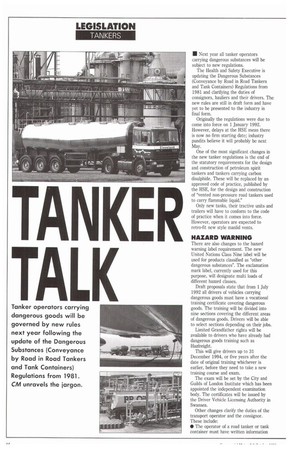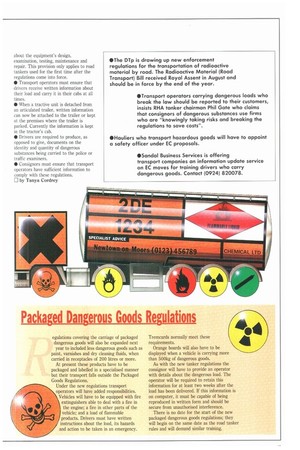TANKER TALK
Page 46

Page 47

If you've noticed an error in this article please click here to report it so we can fix it.
Tanker operators carrying dangerous goods will be governed by new rules next year following the update of the Dangerous Substances (Conveyance by Road in Road Tankers and Tank Containers) Regulations from 1981. CM unravels the jargon.
• Next year all tanker operators carrying dangerous substances will be subject to new regulations.
The Health and Safety Executive is updating the Dangerous Substances (Conveyance by Road in Road Tankers and Tank Containers) Regulations from 1981 and clarifying the duties of consignors, hauliers and their drivers. The new rules are still in draft form and have yet to be presented to the industry in final form.
Originally the regulations were due to come into force on 1 January 1992. However, delays at the HSE mean there is now no firm starting date; industry pundits believe it will probably be next May.
One of the most significant changes in the new tanker regulations is the end of the statutory requirements for the design and construction of petroleum spirit tankers and tankers carrying carbon disulphide. These will be replaced by an approved code of practice, published by the HSE, for the design and construction of "vented non-pressure road tankers used to carry flammable liquid."
Only new tanks, their tractive units and trailers will have to conform to the code of practice when it comes into force. However, operators are expected to retro-fit new style manlid vents.
HAZARD WARNING
There are also changes to the hazard warning label requirement. The new United Nations Class Nine label will be used for products classified as "other dangerous substances". The exclamation mark label, currently used for this purpose, will designate multi loads of different hazard classes.
Draft proposals state that from 1 July 1992 all drivers of vehicles carrying dangerous goods must have a vocational training certificate covering dangerous goods. The training will be divided into nine sections covering the different areas of dangerous goods. Drivers will be able to select sections depending on their jobs.
Limited Grandfather rights will be available to drivers who have already had dangerous goods training such as Hazfreight.
This will give drivers up to 31 December 1994, or five years after the date of original training whichever is earlier, before they need to take a new training course and exam.
The exam will be set by the City and Guilds of London Institute which has been appointed the independent examination body. The certificates will be issued by the Driver Vehicle Licensing Authority in Swansea.
Other changes clarify the duties of the transport operator and the consignor. These include: • The operator of a road tanker or tank container must have written information about the equipment's design, examination, testing, maintenance and repair. This provision only applies to road tankers used for the first time after the regulations come into force.
• Transport operators must ensure that drivers receive written information about their load and carry it in their cabs at all times.
• When a tractive unit is detached from an articulated trailer, written information can now be attached to the trailer or kept at the premises where the trailer is parked. Currently the information is kept in the tractor's cab.
• Drivers are required to produce, as opposed to give, documents on the identity and quantity of dangerous substances being carried to the police or traffic examiners.
• Consignors must ensure that transport operators have sufficient information to comply with these regulations.
D by Tanya Cordrey
















































































































